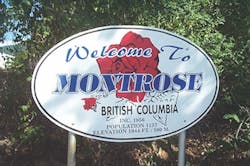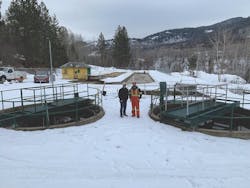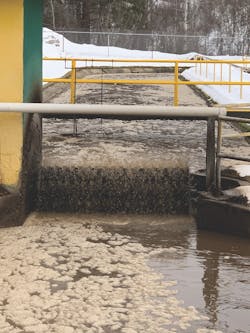About the author:
Chris French is a freelance writer on water, environment and renewable energy. French can be reached at [email protected].
The Trail Times recently reported, “the village of Montrose has been successful in its application for funding under the Infrastructure Canada Grant Program for upgrades to the village’s wastewater treatment facility, a project that will modernize the 56-year-old plant.”
Not that one should be critical of a local newspaper that covers the village in south eastern British Colombia two hours north of Spokane, a publication which understandably knows that its readers will not necessarily require all the finer details of a sewage treatment plant. However, it did not mention the fact that Montrose’s original aeration technology, installed by Lakeside Equipment back in 1963 is still in operation. Not to mention, it is probably the longest lasting engineering of its type to still be in working order in the whole of Canada, perhaps even North America.
It was even further back in 1942 that Leon Simmons had the idea of developing what was then known as Woods Flats—an area of about 220 acres—into a retirement village for workers from the nearby Cominco—now Teck—smelter. In 1956, Woods Flats was incorporated as a village, and as is consistent with many historic connections between Canada and Scotland, was named after the Scottish coastal town of Montrose, which was once razed to the ground by the Danes in the year 980.
In the late 1950’s and early 1960’s, raw drinking water in Montrose BC came from a well that was drilled by the mouth of the Columbia River, into which Beaver Valley Creek flows, but one determined gentleman campaigned for a water treatment facility for his fellow villagers.
At first his concerns fell on deaf ears, but he formed a committee, then ran for council, eventually becoming the mayor during which time he successfully secured a grant for Montrose to have not only its fresh water treated, but to also build a sewer system. The man behind this people power and the introduction of Lakeside’s oxidation ditches back in 1963 was Martin Walsh, whose son Mike, nearly six decades later, is now the current Mayor of Montrose.
“At the time the installation was state-of-the-art,” Walsh said. “All this time later we are going ahead with an upgrade, but the Lakeside equipment is amazing for how old it is. [It’s] still working fine after all these years. My father pushed very hard for Montrose to have efficient and long-lasting treatment systems. Together with his colleagues, they certainly chose wisely.
When the the Lakeside Closed Loop Reactor (CLR) Process was installed, it was sized to fit the village, so it was understandably small. That said, it was designed with the intention to expand as the community would. Walsh said the village took advantage of that in 1980, and the equipment continued to perform admirably.
For most wastewater treatment plants, Lakeside’s racetrack design—referring to the CLR Process—has proved economical, but over time, the reactor has been developed to take on several shapes, including the Folded U, Concentric Multichannel, and for small plants, a round packaged design with an internal final clarifier that offers the lowest construction and equipment cost.
The CLR Process from the Illinois company consists of one or more reactors with a single feed point for raw wastewater and return sludge. The basic design at Montrose uses a simple racetrack configuration that provides a straight-line flow pattern for wastewater between the headworks and the final clarifiers. At the core of the CLR Process is the horizontal Magna Rotor, which sustains a high population of microorganisms in the reactor to provide simple process control. The Magna Rotor provides precise oxygen input into the biological process through adjustment of rotor immersion by raising or lowering the level control weir and by adjusting the rotational speed.
“It’s hard to put into words just how proud we are as a company with the longevity of this equipment at Montrose,” said Warren Kersten, vice president of Lakeside Equipment Corp. “It was our first oxidation ditch installation, and remarkably, it still has the very original rotor aerators in use.”
That longevity, he added, exceeds the life of even some aeration companies.
“Since this inaugural installation back in 1963, more than 2,000 Lakeside systems of this type have been introduced to wastewater treatment plants all over Canada and the U.S.; equipment designed and made here in America,” Kersten said. “None are as old as this one from the early ‘60s, but there are a huge number that have an incredible track record and that are still going strong. Our products are also very low maintenance, but it is still a massive credit to the operators at Montrose that they clearly take very good care of their treatment plant equipment”.
With back up in this part of Canada from Lakeside’s representative, Promag Enviro of Burnaby, the CLR Process is known for its stable operation over a wide range of influent flows and organic loadings as it is specifically designed to minimize the time and effort required to control or adjust the system. Even in cold weather conditions when microorganism activity is decreased, the process operates efficiently without special attention.
The primary component of the CLR Process is its horizontal rotor aerator. The Lakeside Magna Rotor provides oxygen to the biological mass, mixes microorganisms uniformly and adds mixing velocity to the channel to prevent solids from settling. With the Lakeside blades die-formed of 10-gauge AISI Type 304 stainless steel to produce greater stiffness and rigidity, the original rotors at Montrose are capable of taking a 250 pound impact load without deformation, and unsurprisingly are still in working order.
The Montrose Mayor said finding the funding through government programs—Investing in Canada Infrastructure Plant and New Building Canada Fund—to update the plant is an exciting prospect. Most notably, however, he said it will aid the operators, who historically have completed a lot fo manual labor cleaning the screens.
“Since 1963 when my father helped introduce our treatment plant, the number of homes in Montrose has almost doubled from 250 to 430, so we’ve had to reinvest and can’t expect the wastewater equipment to last forever,” Walsh said. “Upgrades to our plant should be completed by the fall of 2021. We know for sure that we have had great service from Lakeside and are pleased to be the owners of the longest serving oxidation ditches."
About the Author
Chris French
Chris French is a freelance writer on water, environment and renewable energy issues. French can be reached at [email protected].




